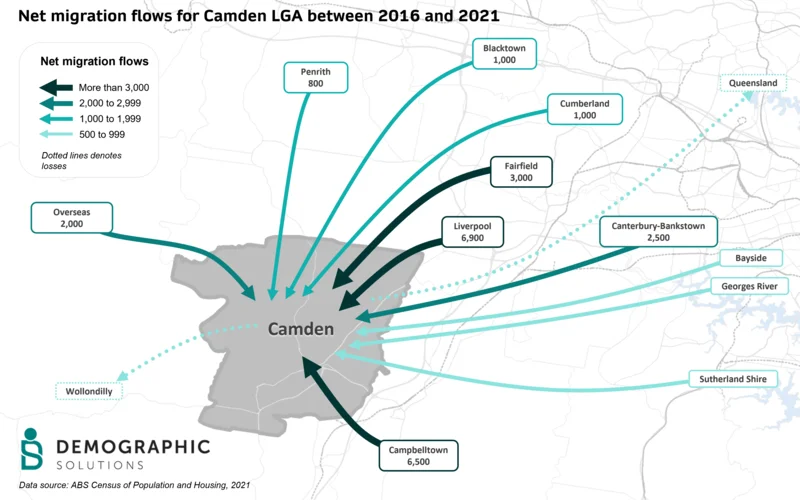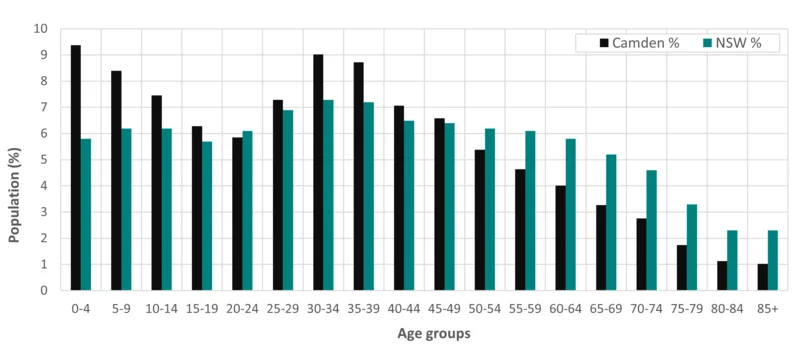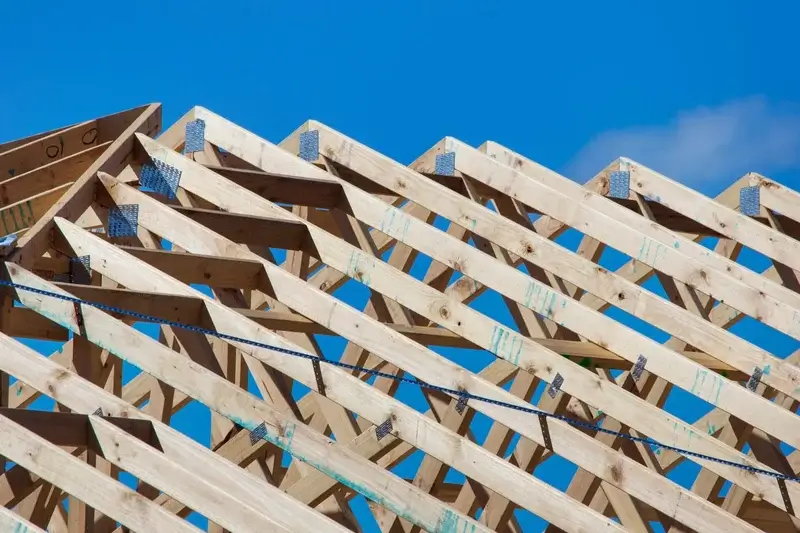In our previous blog “Population growth in New South Wales: Stories from the 2021 Census”, it was revealed that Camden was the fastest growing Local Government Area (LGA) in NSW, going from 78,200 persons in 2016 to 119,325 by 2021; a rate of 52.6%! The next closest LGAs were The Hills Shire (22.0%) and Blacktown (17.7%). Growth in these LGAs was predominantly driven by rapid rates of greenfield residential development in new estates, hence attracting new residents to the area.
"Over half of Camden’s new residents arrive from neighbouring Liverpool and Campbelltown"
The migration map below shows the most significant net flows of people to and from Camden between 2016 and 2021. As expected, Camden gained most of its new residents from neighbouring LGAs, most notably, Liverpool (+6,900) and Campbelltown (+6,500). The area also had notable additions from older established LGAs such as Fairfield (+3,000), Canterbury-Bankstown (+2,500), Cumberland and Blacktown. Camden also gained an estimated 2,000 new residents from overseas.
Net migration flows for Camden, 2016-2021

During this period, Camden also experienced some loss of people to neighbouring Wollondilly (-600) while around 500 people packed their bags and headed north to the Sunshine State.
Camden's younger demographic
Camden continued to attract younger families looking for new and affordable housing opportunities. It had a significantly younger population compared to NSW in 2021 with 76% of the population under the age of 50 (compared to 64.2% for NSW). Only the 20-24 year old share was lower in Camden than NSW as a whole.
Age distribution: Camden Vs NSW, 2021

Data source: ABS Census of Population and Housing, 2021
Camden at the forefront of residential growth in Sydney’s South-West
Camden continued to play a key part in Sydney’s south-west growth corridor providing over 13,400 new dwellings during this period.
Council and Developers (large and small) have been significant players in ensuring a range of products from relatively affordable housing options to developments aimed at mature families. While most suburbs in Camden experienced growth, the most significant development fronts occurred in the following areas:
Oran Park: With over 4,050 new dwellings built between 2016 and 2021, Oran Park accounted for 30% of Camden’s new dwelling stock. This was mainly driven by the Oran Park Town Estate (by Greenfields Development Company) targeted at higher-end first home buyers and mature families.
Gledswood Hills – Gregory Hills: Approximately 3,100 new dwellings were built during the inter-Censal period driven by Gledswood Hills Estate (Sekisui House) and Gregory Hills Estate (Dart West Developments). Gledswood Hills has attracted more established mature families and affluent first-home buyer market while Gregory Hills has provided more affordable housing stock.
Leppington: 1,900 new dwellings were built between 2016 and 2021 mainly in the area between Ingleburn Road and Heath Road and along the Camden Valley Highway. There were a variety of developers at play most notably Crownland Developments, Rawson Communities, Creation Homes and Seed Projects with most of the stock aimed towards mature families and the higher end of the first home buyers’ market.
Spring Farm: The suburb grew by 1,800 new dwellings between 2016 and 2021 driven mainly by the Evergreen Estate (AVJennings) and Spring Farm Estate (Cornish Group) aimed at the affordable housing market.
What is next for Camden?
We can
expect Camden to continue its role in the broader NSW housing market in providing
new housing opportunities for both the affordable and “upgrader” markets. As Glenswood
Hill – Gregory Hills, Oran Park and Spring Farm run out of residential land, Leppington
and the areas along the Northern Road are expected to carry the baton for
Camden to 2030 and beyond. Levels of net migration should remain high, as
Camden continues to “sponge” new residents from neighbouring LGAs (Campbelltown
and Liverpool). It is also probable that Camden will receive a higher number of
new residents from established middle and outer suburbs of Sydney who are
seeking more affordable housing options.


